Get Things Done
Table of Contents
Your mind is for having ideas, not holding them. – David Allen

Horizontal Management
Capture - Collect What has Your Attention
Use an in-basket, notepad, or voice recorder to capture 100% of everything that has your attention. Little, big, personal and professional – all your to-do's, projects, things to handle or finish.
The collection success factors:
- Every open loop must be in your collection system and out of your head;
- You must have as few collection buckets as you can get by with;
- You must empty them regularly.
Ready and go!
Capture:
- Physical Gathering;
- Mental Gathering.
Note that, the objective for the collection process is to get everything into "in" as quickly as possible. Now, we can create a main recipe (M-list).
Clarify - Process What It Means
Take everything that you capture and ask: Is it actionable? If no, then trash it, incubate it, or file it as reference. If yes, decide the very next action required. If it will take less than two minutes, do it now. If not, delegate it if you can; or put it on a list to do when you can.
What is it? Is it actionable?
Now, the main purpose is getting "in" to empty, i.e. to complete every item of M-list. The best way to learn this model is by doing. But there are a few basic rules to follow:
- Process the top item first;
- Process one item at a time;
- Never put anything back into "in".
The key processing question is "What's the Next Action?"
No action required if NO:
- Trash, no longer needed, just delete it;
- Incubate, no action is needed now, but something might need to be done late; (S-list or C-list)
- Reference, the item is potentially useful information that might be needed for something late. (R-list)
Action required if YES:
- Do it now, if an action will take less than 2 minutes;
- Delegate it, if the action will take longer than 2 minutes, and you are not the right person to do it; (W-list or C-list);
- Defer it, same as above, but you are the right person. (N-list or C-list)
Organize - Put It Where It Belongs
Put action reminders on the right lists. For example create lists for the appropriate categories – calls to make, errands to run, emails to send, etc.
To a complex NEXT-ACTION, it might need a plan. (P-list)
Next actions (N-list) along with Calendar (C-list) are the core of daily action-management organization.
Just three type of actions go on your calendar:
- time-specific action;
- day-specific actions; and
- day-specific information.
Except three things above, put the others into N-list. Note that, the calendar should show only the "hard landscape" around which you do the rest of your actions.
Reflect - Review Frequently
Look over your lists as often as necessary to determine what to do next. Do a weekly review to clean up, update your lists, and clear your mind.
Reviewing: keeping your system functional. What to look at, when?
- Looking at your calendar first (C-list); then
- Your next action list (N-list).
Note that do the right review in the right context to updating your system.
Thinking is the very essence of and the most difficult thing to do in business and in life. Empire builders spend hour-after-hour on mental work while others party. If you're not consciously aware of putting forth the effort to exert self-guided intergrated thinking, then you're giving it to laziness and no longer control your life.
Engage - Simply Do
Use your system to take appropriate actions with confidence.
Three priority frameworks to be enormously helpful in the context of deciding actions:
- The four-criteria model for choosing actions in the moment;
- Context;
- Time available;
- Energy available; and
- Priority.
- The threefold model for evaluating daily work:
- Doing predefined work;
- Doing works as it shows up; and
- Defining your work.
- The six-level model for reviewing your own work:
- 50,000+ feet: Life;
- 40,000 feet: Three-to-five-year visions;
- 30,000 feet: One-to-two-yeay goals;
- 20,000 feet: Areas of responsibility;
- 10,000 feet: Current projects;
- Runway: Current actions.
Vertical Management
What I call horizontal focus is that:
- Clearly defined outcomes (projects) and the next actions required to move them toward closure, and
- reminders placed in a trusted system that is reviewed regularly.
The core of vertical management the natural planning model which has 5 levels:
- Defining purpose and principles;
- Outcome visioning;
- Brainstorming;
- Organizing;
- Identifying next actions.